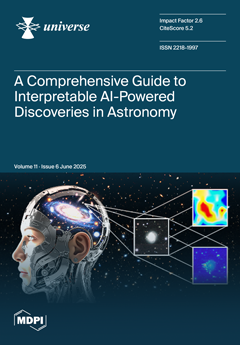As an alternative gravitational theory to General Relativity (GR), Conformal Gravity (CG) can be verified through astronomical observations. Currently, Mannheim and Kazanas have provided vacuum solutions for cosmological and local gravitational systems, and these solutions may resolve the dark matter and dark energy
[...] Read more.
As an alternative gravitational theory to General Relativity (GR), Conformal Gravity (CG) can be verified through astronomical observations. Currently, Mannheim and Kazanas have provided vacuum solutions for cosmological and local gravitational systems, and these solutions may resolve the dark matter and dark energy issues encountered in GR, making them particularly valuable. For static, spherically symmetric systems, CG predicts an additional linear potential generated by luminous matter in addition to the conventional Newtonian potential. This extra potential is expected to account for the observations of galaxies and galaxy clusters without the need of dark matter. It is characterized by the parameter
, which corresponds to the linear potential generated by the unit of the solar mass, and it is thus a universal constant. The value of
was determined by fitting the rotation curve data of spiral galaxies. These predictions of CG should also be verified by the observations of strong gravitational lensing. To date, in the existing literature, the observations of strong lensing employed to test CG have been limited to a few galaxy clusters. It has been found that the value of
estimated from strong lensing is several orders of magnitude greater than that obtained from fitting rotation curves. In this study, building upon the previous research, we tested CG via strong lensing statistics. We used a well-defined sample that consisted of both galaxies and galaxy clusters. This allowed us to test CG through statistical strong lensing in a way similar to the conventional approach in GR. As anticipated, our results were consistent with previous studies, namely that the fitted
is much larger than that from rotation curves. Intriguingly, we further discovered that, in order to fit the strong lensing data of another sample, the value of
cannot be a constant, as is required in CG. Instead, we derived a formula for
as a function of the stellar mass
of the galaxies or galaxy clusters. It was found that
decreases as
increases.
Full article





